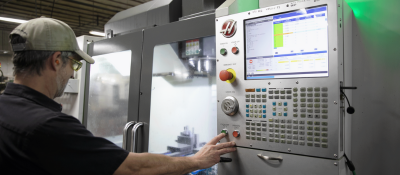Your Cart is Empty

8 Ways to Increase the Energy Efficiency of your Compressed Air System
Compressed air is essential for many industrial applications. However, it is expensive to produce. The total cost of ownership should be a factor when considering a compressed air system. Here are eight ways to increase the efficiency of your compressed air system.
Estimated read time: 7 minutes
Table of Contents
- Limit Compressed Air Use
- Fix Leaks
- Turn Down the Pressure
- Utilize the Heat
- Perform Regular Maintenance
- Optimize Air Piping
- Switch to Variable Frequency Drive Technology
- Take Advantage of Energy Incentives
Many facilities are surprised to learn that energy is the biggest cost when operating compressed air, not the compressor itself. For example, a compressor with a price tag of $5,000 over 10 years will actually cost $35,000. That’s $5,000 to purchase the compressor, and $30,000 in energy usage to run for a decade.
Key Takeaways:
-
Regular Maintenance and Leak Detection — conduct routine inspections to identify and repair leaks in the compressed air system. Even small leaks can lead to significant energy losses over time.
- Optimize System Pressure — operate the compressed air system at the lowest possible pressure that meets production requirements. Reducing system pressure decreases energy consumption and minimizes the risk of leaks.
- Use Energy-Efficient Equipment — invest in energy-efficient components, such as variable-speed drive compressors, which adjust motor speed to match air demand, leading to energy savings.
- Recover Waste Heat — implement heat recovery systems to capture and reuse waste heat generated by compressors, improving overall energy efficiency.
- Train Personnel — educate employees on best practices for operating and maintaining compressed air systems to ensure energy-efficient practices are consistently followed.
Because of the high cost of energy, it’s important to make your compressed air system as efficient as possible. Here are 8 ways to decrease your energy bill while also increasing the efficiency of your compressed air system:
1: Limit Compressed Air Use
This first method is simple: when compressed air is not needed, turn the compressor off. It’s like turning your car off when you park in your driveway. A 20hp compressor can cost $175 per week to run 24/7.
If you have different tools that can get the same job done, use them. Battery-powered tools like impact wrenches or drills can be less expensive to use, replacing the pneumatic tool when not in peak demand times. Compressed air used in drying, aeration or sparging, and pneumatic conveying applications can often be replaced by a low-pressure, lower horsepower (HP) blower.
Another important factor when limiting compressed air use is avoiding inappropriate uses of compressed air. This is not only helpful in energy savings, but for safety measures as well. Uses like personal cooling, sweeping the floor and creating air blasts for entertainment should all be avoided.
2: Fix Leaks
Locating and fixing leaks in your compressed air system is essential to improving its energy efficiency. Leaks can account for 20% or more of system demands. The easiest repairs to make are replacing rubber hoses and quick connects. This can be easily done and will improve efficiency.
To find all leaks in your system, a formal leak audit can be performed with ultrasonic leak detectors. These detectors can be used in loud environments where leaks cannot be heard. The audit team will log data, evaluate the findings and present a solution to resolve the leaks in your system.
Pro Tip:Remember the old trick to finding leaks in your bike tires? That works for compressed air piping too. Simply spray soapy water on the lines and locate the places where bubbles appear. There’s your leak!
RELATED: BENEFITS OF AIR SYSTEM AUDITS: WHEN YOU NEED ONE AND HOW TO DO THEM

3: Turn Down the Pressure
When an issue with an air tool occurs, many people’s first instinct is to turn up the pressure. Because of this, plants often run at a higher pressure than needed. Keeping compressed air flowing at proper pressures can help facilities save big over time. For every 2psi that the compressed air pressure is lowered, 1% of energy is saved. You’ll save 10% power just by turning the pressure of your air compressor from 120psi to 100psi.
Additionally, all unregulated air leaks and uses will consume less air at lower pressure, creating a double benefit. Your facility will experience reduced power requirements per cubic food of air and overall lower air consumption.
Here are some other ways to lower the pressure of your compressed air system:
1. Add a receiver tank. These tanks store air for future use and can be a great help to your system.
2. Shorten rubber hoses. This can reduce friction loss, lower demand for increased supply pressure, and help minimize the risk of leaks in the hose.
3. Use the correct piping in your system. Diameter, material choice and excessive fittings or bends can all affect the pressure across your facility. Contact an expert for system recommendations.
4: Utilize the Heat
Did you know that 85% of energy used for compressing air is rejected as heat? That’s a huge percentage of energy. The good news is that your facility can utilize the rejected heat in many useful ways:
1. Heat other areas of your plant with the outlet air from the compressor. Use ducting to carry the hot air elsewhere in the facility.
2. Liquid-cooled heat exchangers can be plumbed in to warm water for boiler pre-heat and many other applications.
3. Heat from the compressor can be used in dehumidifying systems to remove moisture from the air or space as needed.
Success Story: Nestlé Ice Cream
An initial cooling plan for the air compressors involved ducting the cooling air out the roof. This would dramatically reduce the heat load inside the utilities area, but Nestlé’s global commitment to energy efficiency presented a challenge: could that air be put to work? They asked our team, who designed and implemented a system to recover BTUs rejected from the air-cooled compressors to heat water.
READ THE FULL CASE STUDY HERE

Cooling system at the Nestle Ice Cream Plant in Tulare, CA.
5: Perform Regular Maintenance
All rotating equipment requires periodic maintenance. Regular fluid and filter changes maximize longevity and uptime. Technicians can also diagnose and make adjustments to the system and fine-tune energy efficiency.
All components of your compressed air system should receive routine maintenance, not just the compressor. This includes:
Dryers: Both refrigerated and desiccant dryer filters should be changed regularly. Refrigerated dryer filters are changed every 1,000 hours of run time, while desiccant filters are changed annually.
Desiccant dryers require a bit more maintenance. The desiccant medium inside the tanks needs to be monitored and replaced. Here are two main methods to tell if your desiccant needs to be replaced:
1. The dew point is suffering. If your dew point has vastly increased from the normal level, you’ll need to look into replacing the desiccant.
2. Pressure drop throughout the desiccant bed. Desiccant ages and becomes more brittle. As this happens, tiny pieces of desiccant break off and can fill up the voids in the desiccant bed. Because of this, pressure drop will start to go up through that bed. Quality desiccant will become brittle less quickly.
The good news: you can test your desiccant before replacing it. Your local distributor should have test kits available upon request. It’s best to test your desiccant while you’re doing other maintenance on the dryer to make the process even simpler.
Filters:Changing filters largely depends on system usage, but it’s recommended to change filter media at least once a year. The higher the demand on your system, the more frequently you’ll need to change the filters. If your system operates in a dusty or dirty environment, the filters will need to be replaced more frequently. Ask your service team to inspect and advise on filter conditions and replacement.
Drains:Drains should be inspected daily, or as frequently as an operator can make rounds. If the drain is not performing, the system is going to be compromised shortly thereafter. Make drain inspection part of the operators’ walkthrough checklist.
Compressed Air Maintenance Intervals
Scheduling routine maintenance is key to keeping efficiency at its peak. As a rule of thumb, service should occur every 1,000 hours. Think of it like a cleaning at the dentist, or a vehicle oil change. It’s important to make sure everything is running smoothly to avoid critical failure.
Every Rogers compressor is serviced at 1,000 hours, to change filters, inspect operation, and take oil samples. Cleaning, basic maintenance and further inspection during future service helps keep the compressor in the best shape possible.
Need help with maintenance? Contact our service team.
RELATED: How to Select the Right Dryer for Your Air Compressor

6: Optimize Air Piping
As mentioned in method #3, optimizing your system piping can have a big impact on your bottom line and efficiency. Compressed air and other gasses need as straight a path as possible. Piping with extra bends will cause more pressure loss as the gas attempts to take this tortuous path.
Many compressed air systems are run at higher than ideal pressure due to problems with piping. Ideal systems have a “ladder” or “ring” style piping system resulting in low pressure drop.
When optimizing piping, also consider restrictions from flex hoses, clogged filters and excessive use of splitters on manifolds. In addition, make sure you’re using the correct type of piping for the application.
7: Switch to Variable Frequency Drive (VFD) Technology
A variable frequency drive compressor operates as-needed. The motor controls the air flow to match the demands of the facility, kicking into higher gear for peak demand times and switching off when air is not in use. VFD compressors are inherently more efficient than a fixed-speed drive, since they can match demand.
While other control types also match demand, the key to VFD-controlled compressors’ efficiency is that the VFD varies the motor speed to match demand. This creates a nearly 1-to-1 proportional relationship between the flow and power. Older types of compressors use less-efficient inlet modulation or load-unload controls to maintain plant pressure.
The VFD is the most efficient control system over a broad range of flows.
Success Story: Safeway Milk Plant
In 2006, the Safeway Milk Plant became an early adopter of energy efficient air compressors by installing a 150 horsepower (hp), variable frequency drive (VFD) air compressor. The energy savings were verified and for the last 13 years, the system has been running 24/7.
Energy benefits:
- Annual cost savings of 212,000 kWh
- Cost savings of $15,700/year
- Final payback period of 2.6 years
- Reliable, clean compressed air
READ THE FULL CASE STUDY

The Safeway Milk Plant utilizes VFD technology to increase energy savings.
8: Take Advantage of Energy Incentives
Many power companies or organizations offer significant financial incentives to help purchase new, energy-efficient compressed air equipment. With the help of calculation tools, monitoring equipment and air system audits, estimated energy savings can be calculated, as well as a payback window to upgrade the system. Simple paybacks of 1-2 years are common for upgraded, energy-efficient systems.
Before spending the capital expense to upgrade your system, it’s important to be in the know. Either check with your utility company or our compressed air experts to find out about potential incentives to help pay back your compressor or other upgrade.

Upgrading your compressed air system is just one of the many ways your facility can increase energy efficiency. By taking a few simple steps to turn down pressure and limit compressed air use, you’ll save thousands on your energy bottom line. Speak with an expert about the next steps to make your compressed air system more efficient.
You May Also be Interested In:
The Second Stage of Energy Savings: Safeway Milk Plant
How to Justify Capital Investment for Air Compressor and Vacuum Pump Systems
J.M. Huber Improves Efficiency and Avoids Downtime
Meet the Contributor
 |
Ryan French joined the Rogers Machinery Audits and Consulting Group fresh out of college in 2021. Prior to entering the industry full time, he conducted plant-wide industrial energy assessments for three years with the Oregon State University Industrial Assessment Center. |





